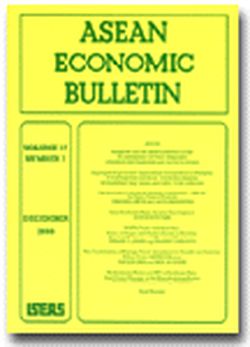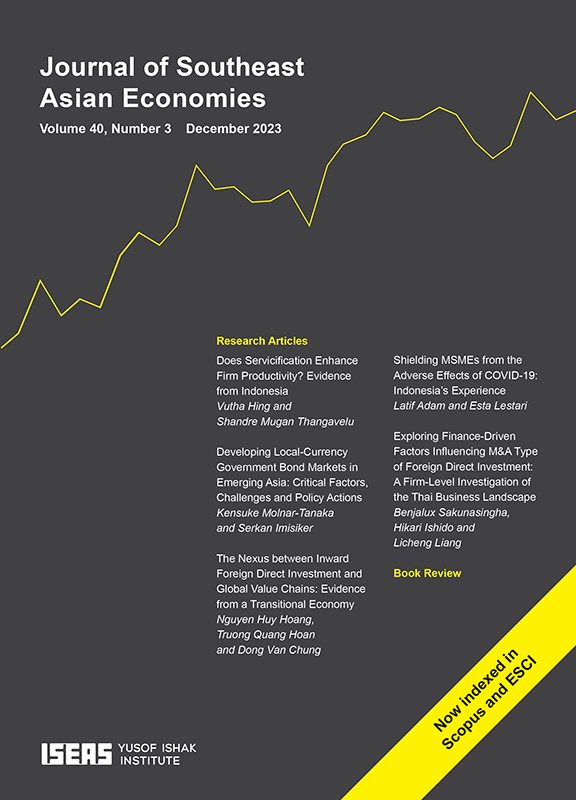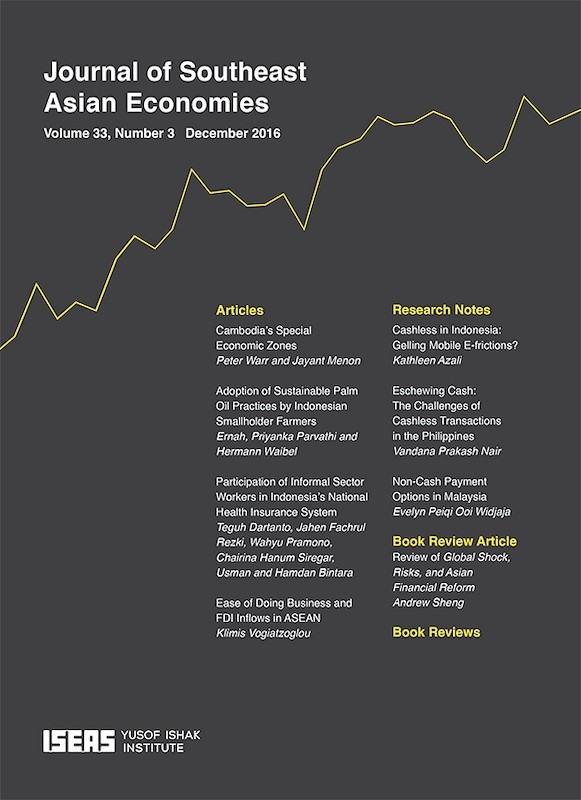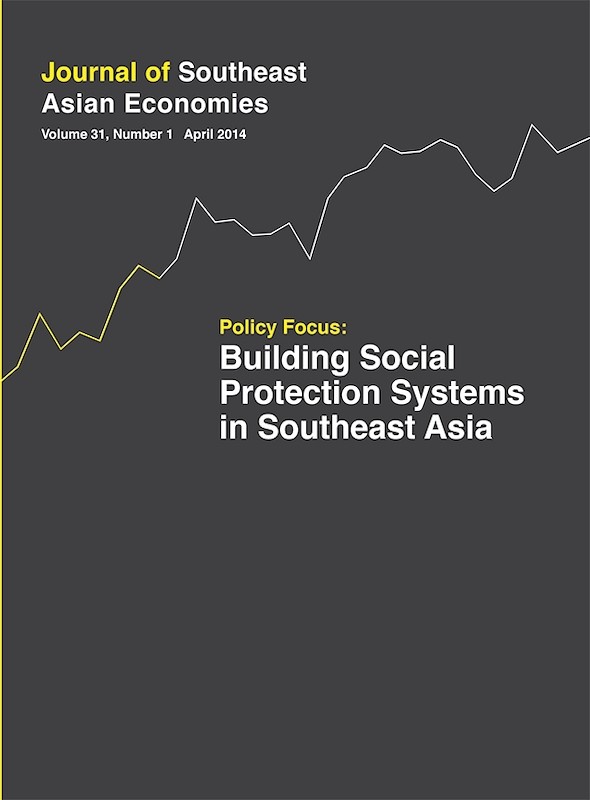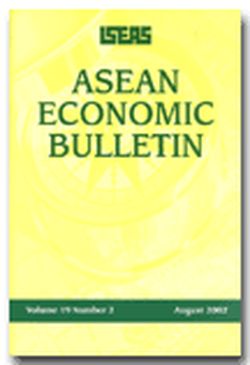ASEAN Economic Bulletin Vol. 28/1 (Apr 2011)
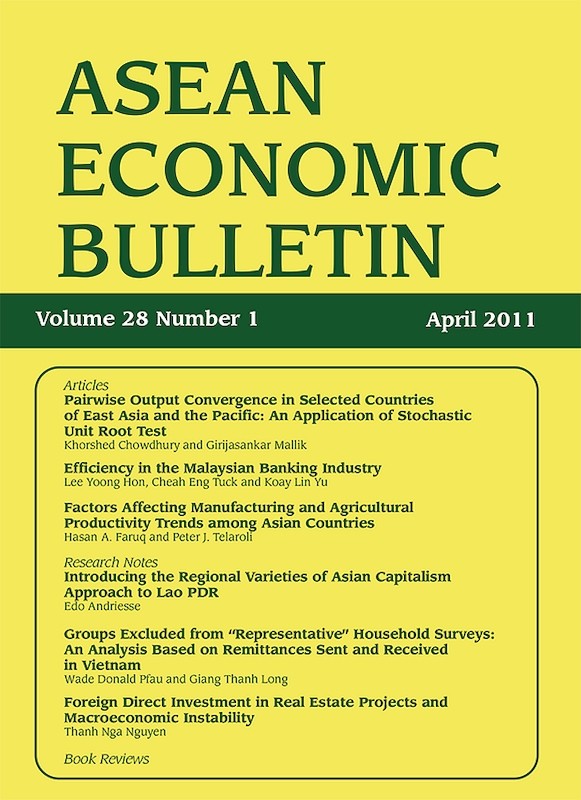
Date of publication:
April 2011
Publisher:
Institute of Southeast Asian Studies
Number of pages:
105
Code:
AE28/1
Contents
-
ASEAN Economic Bulletin Vol. 28/1 (Apr 2011)
[Whole Publication] -
Preliminary pages
- ARTICLES
-
Pairwise Output Convergence in Selected Countries of East Asia and the Pacific: An Application of Stochastic Unit Root Test, by Khorshed Chowdhury, Girijasankar Mallik, authors see abstractThis paper examines time series cross-country output convergence in eleven counties of East Asia and the Pacific. Specifically, we model the cross-country output differences as a Stochastic Unit Root (STUR) processes. Using the output-differences between Japan (reference country) and the other ten sampled countries, we find output convergence only for the Japan-Australia, Japan-New Zealand, Japan-Taiwan and Japan-Thailand country-pairs. Alternatively, using the output-differences between Australia (reference country) and the other ten sampled countries, we fail to find any evidence of convergence in seven country pairs of the sampled countries except for Australia-Japan, Australia-Hong Kong and Australia-NewZealand country pairs. Overall, our results do not support output convergence in a broader perspective but support the notion of club convergence among a small subset (3040 per cent) of similar fast-growing economies. The causes for non-convergence of per capita real GDP for a majority of country pairs are an empirical issue that involves country-specific factors that render output gaps highly persistent, but we can broadly outline a few reasons for non-convergence and these include, low and unequal economic growth, lack of economic and financial integration among the sampled countries.
-
Efficiency in the Malaysian Banking Industry, by Lee Yoong Hon, Cheah Eng Tuck, Koay Lin Yu, authors see abstractThis paper aims to examine the efficiency of ten Malaysian anchor banks from 2001 to 2005, a period representing the first five years of the country's Financial Sector Master Plan(FSMP) which was aimed at developing a more resilient, competitive and dynamic financial system with the best practices, among others. This paper used data envelopment analysis and the Malmquist index to analyze the efficiency and productivity issues surrounding the industry. The results indicated that the FSMP did in fact stimulated efficiency growth in terms of technological innovation but did not seem to have much impact on the technical efficiency or scale efficiency. These findings suggest that there is still some catching-up for the inefficient banks in the sample to be more competitive in order to face a more liberalized and globalized environment in the years to come.
-
Factors Affecting Manufacturing and Agricultural Productivity Trends among Asian Countries see abstractManufacturing productivity has been increasing faster relative to agricultural productivity in a number of Asian countries in recent years. The literature provides two hypotheses for this phenomenon. First, increases in physical capital investment led to manufacturing productivity growth in many Asian countries (Tinakorn and Sussangkarn 1994). Second, greater exposure to trade and foreign direct investment contributed to improvements in manufacturing productivity (Pack and Westphal 1998). Using data from several Asian countries between 1970 and 2005, we find that OLS regressions only support the first hypothesis. However, after we account for the endogeneity between openness and FDI inflows, we find evidence supporting the second hypothesis. These results have various implications for trade and FDI policies.
- RESEARCH NOTES
-
Introducing the Regional Varieties of Asian Capitalism Approach to Lao PDR, by Edo Andriesse, author see abstractThis research note proposes the entry of the emerging body of knowledge on Varieties of Asian Capitalism into Lao PDR, Cambodia and Vietnam. While geographers and economists have begun to study capitalist diversity in several Southeast Asian countries, former "Indochine" has so far been neglected. This seems to be an omission as economic reform in these three countries provides much scope for varieties of capitalism research. After an update on the latest theoretical insights this note introduces a research agenda focusing on capitalist institutions and its evolution in Lao PDR. Here, Savannakhet province in the southern part of the country is presented as a potential suitable research site, but it is hoped that both academics and policy-makers take up this agenda in order to increase our comparative knowledge of capitalist institutions and its potential to achieve poverty reduction in peripheral regions of Lao PDR, Cambodia and Vietnam.
-
Groups Excluded from "Representative" Household Surveys: An Analysis Based on Remittances Sent and Received in Vietnam, by Wade Donald Pfau, Giang Thanh Long, authors see abstractThe Vietnam Living Standard Surveys (VLSS), a part of the World Banks Living Standards Measurement Study Household Surveys, are supposed to be representative of the entire population in Vietnam. However, we uncover an anomaly that the amount of remittances received from domestic sources is significantly larger than the amount of remittances sent to domestic sources, implying that the survey is at least not representative of remittance senders. By further exploring a unique characteristic of the survey questions about remittances, we determine that, in particular, female and urban-dwelling remittance senders are underrepresented in the survey.
-
Foreign Direct Investment in Real Estate Projects and Macroeconomic Instability, by Thanh Nga Nguyen, author see abstractOne of the main determinants of Vietnam's high economic growth for more than two decades has been its capability to attract foreign direct investment (FDI). FDI has contributed to economic growth through increasing manufacturing exports, creating employment and enhancing total factor productivity. However, this paper argues that the inflow of FDI into the country's real estate and construction sectors stimulated by the property market bubble has contributed to macroeconomic instability. Although the government's policy space to deal with these effects is limited, it should enhance its supervision and encourage FDI into labour intensive manufacturing sectors.
- BOOK REVIEWS
-
BOOK REVIEW: Bounding the Mekong: The Asian Development Bank, China, and Thailand, by Jim Glassman, by Pavin Chachavalpongpun, author
-
BOOK REVIEW: The Indonesian Labour Market: Changes and Challenges, by Shafiq Dhanani, Iyanatul Islam and Anis Chowdhury, by Jennifer Yang Hui, contributor
-
BOOK REVIEW: Southeast Asia: The Long Road Ahead, by Lim Chong Yah, by Robert L Curry, Jr., author
-
BOOK REVIEW: Exchange Rates, Currency Crisis and Monetary Cooperation in Asia, by Ramkishen S. Rajan, by Tony Cavoli, author

